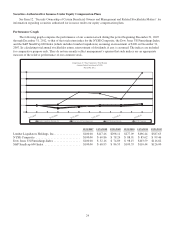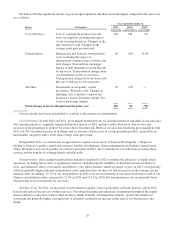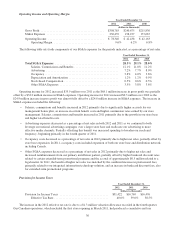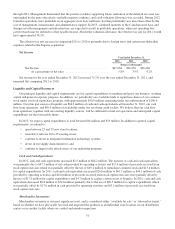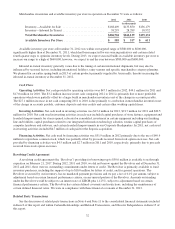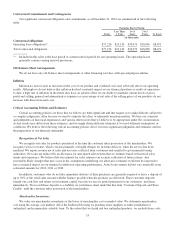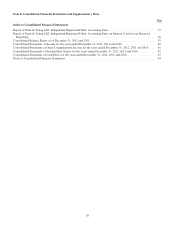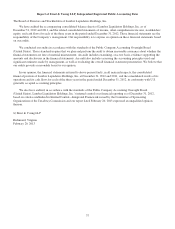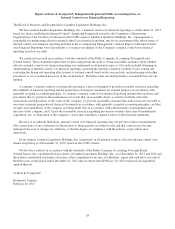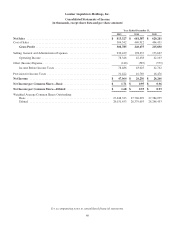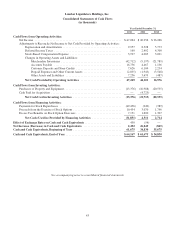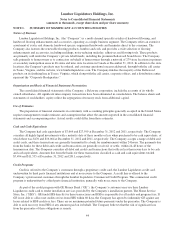Lumber Liquidators 2012 Annual Report Download - page 40
Download and view the complete annual report
Please find page 40 of the 2012 Lumber Liquidators annual report below. You can navigate through the pages in the report by either clicking on the pages listed below, or by using the keyword search tool below to find specific information within the annual report.in the average unit cost of related merchandise inventory. In determining market value, we make judgments and estimates as
to the market value of our products, based on factors such as historical results and current sales trends. Any reasonably likely
changes that may occur in those assumptions in the future may require us to record charges for losses or obsolescence against
these assets, but would not be expected to have a material impact on our financial condition or operating performance. Actual
losses and obsolescence charges did not vary materially from estimated amounts for 2012, 2011 or 2010.
Stock-Based Compensation
We currently maintain a single equity incentive plan under which we may grant non-qualified stock options, restricted
shares, stock appreciation rights and other equity awards to employees and non-employee directors. We recognize expense
for our stock-based compensation based on the fair value of the awards that are granted. Measured compensation cost is
recognized ratably over the service period of the related stock-based compensation award.
The fair value of stock options was estimated at the date of grant using the Black-Scholes-Merton valuation model. In
order to determine the related stock-based compensation expense, we used the following assumptions for stock options
granted during 2012:
• Expected life of 6.5 years to 7.5 years;
• Expected stock price volatility of 45%;
• Risk-free interest rates from 1.0% to 1.6%; and
• Dividends are not expected to be paid in any year.
The expected stock price volatility range is based on a combination of historical volatility of our stock price and the
historical volatilities of companies included in a peer group that was selected by management whose shares or options are
publicly available. The volatilities are estimated for a period of time equal to the expected term of the related option. The
risk-free interest rate is based on the implied yield of U.S. Treasury zero-coupon issues with an equivalent remaining term.
The expected term of the options represents the estimated period of time until exercise and is determined by considering the
contractual terms, vesting schedule and expectations of future employee behavior. Had we arrived at different assumptions of
stock price volatility or expected terms of our options, our stock-based compensation expense and result of operations could
have been different.
New Accounting Pronouncements
In September 2011, the FASB issued guidance that revises the requirements around how entities test goodwill for
impairment. The guidance allows companies to perform a qualitative assessment before calculating the fair value of the
reporting unit. If entities determine, on the basis of qualitative factors, that the fair value of the reporting unit is more likely
than not greater than the carrying amount, a quantitative calculation would not be needed. We adopted this guidance for our
fiscal 2012 annual goodwill impairment test.
Item 7A. Quantitative and Qualitative Disclosures About Market Risk.
Interest Rate Risk.
We are exposed to interest rate risk through the investment of our cash and cash equivalents. We invest our cash in
short-term investments with maturities of three months or less. Changes in interest rates affect the interest income we earn,
and therefore impact our cash flows and results of operations. In addition, any future borrowings under our revolving credit
agreement would be exposed to interest rate risk due to the variable rate of the facility.
We currently do not engage in any interest rate hedging activity and currently have no intention to do so in the
foreseeable future. However, in the future, in an effort to mitigate losses associated with these risks, we may at times enter
into derivative financial instruments, although we have not historically done so. We do not, and do not intend to, engage in
the practice of trading derivative securities for profit.
Exchange Rate Risk.
The majority of our revenue, expense and capital purchasing activities are transacted in U.S. dollars. However, because
a portion of our operations consists of activities outside of the U.S., we have transactions in or exposure to other currencies,
including the Euro, Canadian dollar, Chinese yuan and Brazilian real.
34


